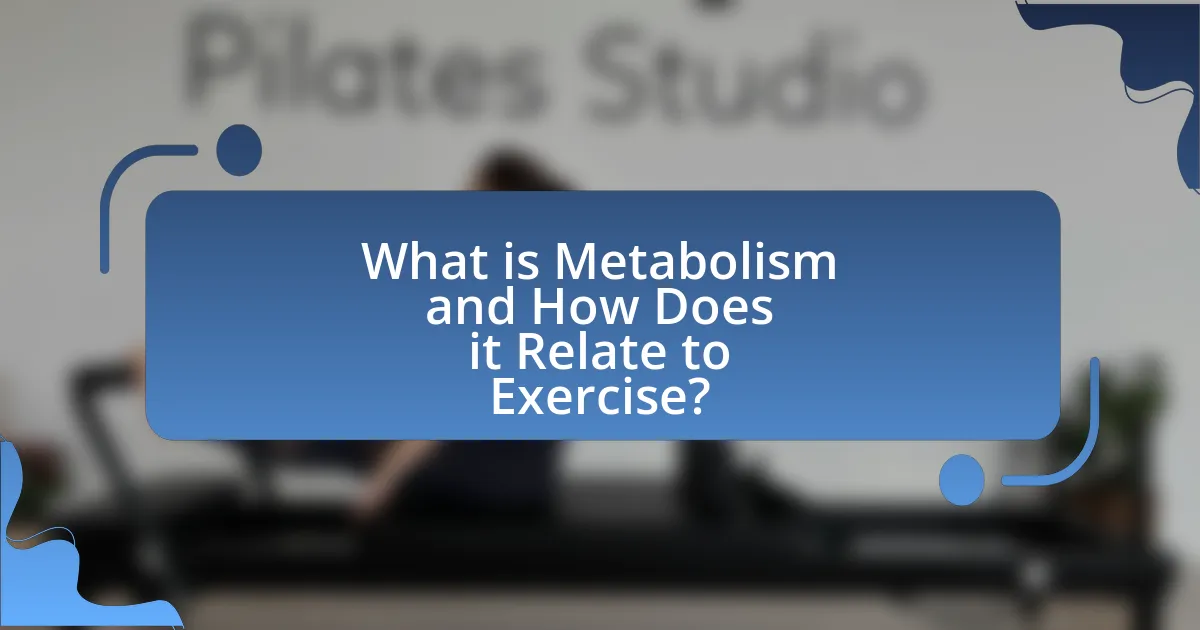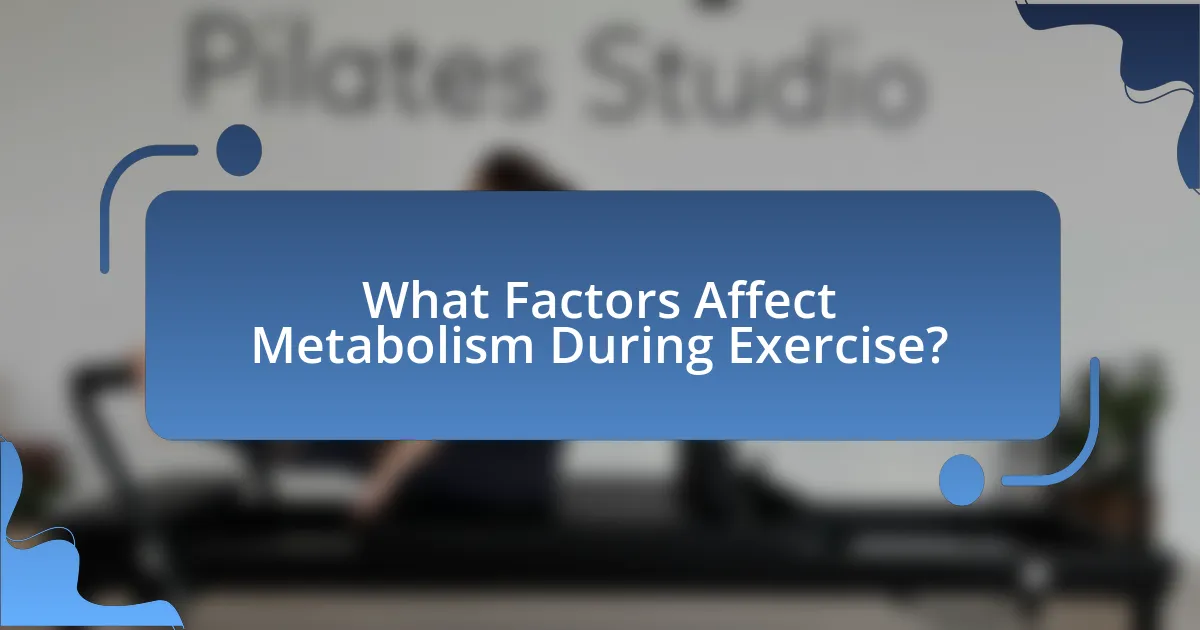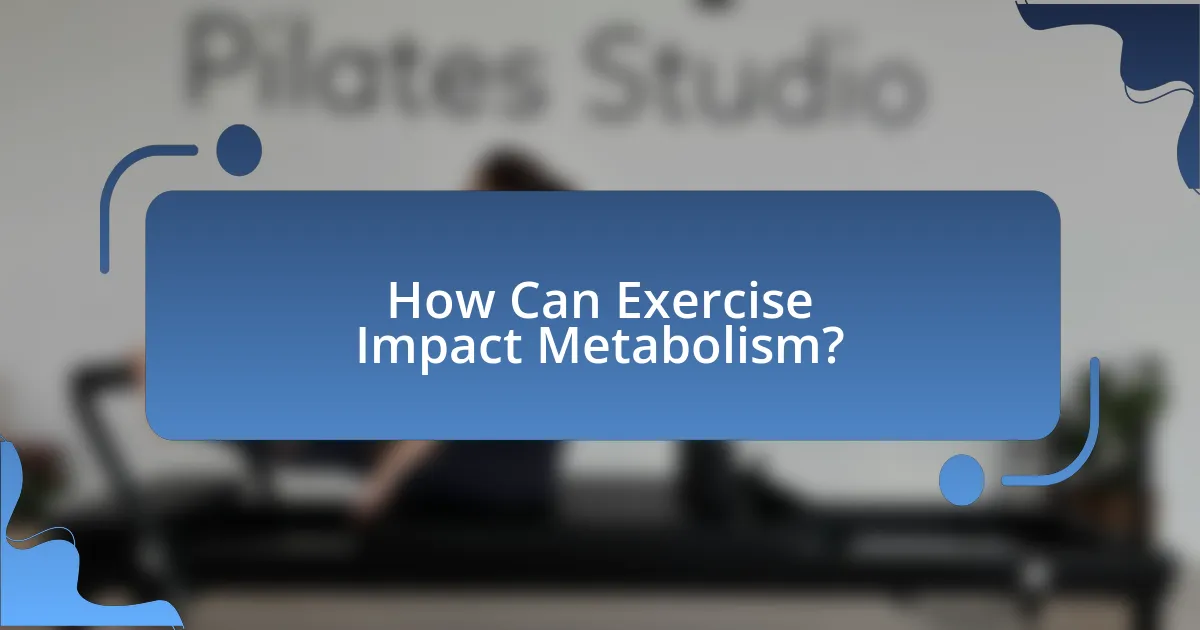Metabolism refers to the biochemical processes that convert food into energy, playing a crucial role in exercise performance and recovery. This article explores the relationship between metabolism and exercise, detailing how metabolic rates change during physical activity, the types of metabolism involved, and the impact of factors such as age, gender, and genetics. It also examines how different exercise modalities, including high-intensity interval training and strength training, can enhance metabolic efficiency and overall energy expenditure. Additionally, the article highlights the importance of nutrition and lifestyle changes in optimizing metabolism for improved health and fitness outcomes.

What is Metabolism and How Does it Relate to Exercise?
Metabolism is the set of life-sustaining chemical reactions in organisms that convert food into energy. This process is crucial for exercise because it determines how efficiently the body can utilize nutrients to fuel physical activity. During exercise, the metabolic rate increases, leading to a higher demand for energy, which is derived from carbohydrates, fats, and proteins. Research indicates that regular exercise can enhance metabolic efficiency, allowing the body to burn calories more effectively even at rest. For instance, a study published in the Journal of Applied Physiology found that individuals who engage in consistent aerobic exercise experience an increase in their resting metabolic rate, demonstrating a direct relationship between metabolism and exercise.
How is metabolism defined in the context of exercise?
Metabolism in the context of exercise is defined as the biochemical processes that convert food into energy to fuel physical activity. This includes both catabolic processes, which break down nutrients to release energy, and anabolic processes, which use energy to build and repair tissues. During exercise, the body increases its metabolic rate to meet the heightened energy demands, utilizing carbohydrates and fats as primary energy sources. Research indicates that regular exercise can enhance metabolic efficiency, leading to improved energy utilization and weight management.
What are the different types of metabolism?
The different types of metabolism are catabolism and anabolism. Catabolism refers to the breakdown of molecules to obtain energy, while anabolism involves the synthesis of all compounds needed by the cells. These metabolic processes are essential for maintaining energy balance and supporting cellular functions. For instance, during catabolism, glucose is broken down in cellular respiration to produce ATP, the energy currency of the cell, demonstrating the critical role of catabolic pathways in energy production. Conversely, anabolic processes, such as protein synthesis, are vital for growth and repair, highlighting the importance of both types of metabolism in overall health and fitness.
How does metabolism change during physical activity?
Metabolism increases during physical activity due to heightened energy demands from muscles. When engaging in exercise, the body requires more adenosine triphosphate (ATP) to fuel muscle contractions, leading to an uptick in metabolic rate. This increase can be quantified; for instance, during vigorous exercise, the metabolic rate can rise by 15 to 20 times the resting level. Additionally, the body shifts from using primarily fat as an energy source at rest to utilizing carbohydrates more during intense activity, reflecting a metabolic adaptation to support immediate energy needs.
Why is understanding metabolism important for exercise?
Understanding metabolism is crucial for exercise because it directly influences energy production and utilization during physical activity. Metabolism encompasses the biochemical processes that convert food into energy, which is essential for sustaining exercise performance. For instance, during high-intensity workouts, the body primarily relies on anaerobic metabolism, which provides quick energy through glucose breakdown. Conversely, during prolonged, lower-intensity activities, aerobic metabolism becomes predominant, utilizing fat as a fuel source. Research indicates that individuals with a higher metabolic rate can burn more calories at rest and during exercise, enhancing weight management and overall fitness levels. Therefore, comprehending how metabolism functions allows individuals to tailor their exercise regimens and nutritional strategies for optimal performance and health outcomes.
How does metabolism influence energy levels during workouts?
Metabolism significantly influences energy levels during workouts by determining how efficiently the body converts food into usable energy. A higher metabolic rate allows for quicker energy production, which is crucial during physical activity. For instance, individuals with a faster metabolism can utilize carbohydrates and fats more effectively, leading to sustained energy levels throughout their workouts. Research indicates that metabolic processes, such as glycolysis and oxidative phosphorylation, play vital roles in energy production, with studies showing that athletes often have higher metabolic rates compared to sedentary individuals, enabling them to perform at higher intensities for longer durations.
What role does metabolism play in recovery after exercise?
Metabolism plays a crucial role in recovery after exercise by facilitating the repair and rebuilding of muscle tissues, replenishing energy stores, and regulating the removal of metabolic waste. During recovery, the metabolic processes increase protein synthesis, which is essential for muscle repair, and enhance glycogen resynthesis, restoring energy levels depleted during physical activity. Research indicates that elevated metabolic rates post-exercise can last for several hours, contributing to ongoing recovery processes. For instance, a study published in the Journal of Applied Physiology found that post-exercise metabolism can increase energy expenditure by 15-30% for up to 48 hours, underscoring the importance of metabolism in effective recovery.

What Factors Affect Metabolism During Exercise?
Metabolism during exercise is primarily affected by factors such as exercise intensity, duration, type of exercise, individual fitness level, and nutritional status. Higher exercise intensity increases energy expenditure and metabolic rate due to greater demand for ATP production. For instance, high-intensity interval training (HIIT) can elevate metabolism significantly compared to moderate-intensity steady-state exercise. The duration of exercise also plays a role; longer sessions can lead to increased fat oxidation as glycogen stores deplete.
The type of exercise influences metabolic pathways; aerobic activities primarily utilize fat, while anaerobic activities rely on carbohydrates. Individual fitness levels affect metabolic efficiency; trained individuals often have a higher metabolic rate due to increased muscle mass and improved cardiovascular function. Lastly, nutritional status, including carbohydrate and protein intake, can impact energy availability and recovery, further influencing metabolic responses during and after exercise.
How do age and gender influence metabolic rates?
Age and gender significantly influence metabolic rates, with younger individuals generally having higher metabolic rates than older adults. This is primarily due to the decline in muscle mass and hormonal changes associated with aging, which reduce the basal metabolic rate (BMR). For instance, research indicates that BMR decreases by approximately 2-3% per decade after the age of 20.
Gender also plays a crucial role, as males typically have a higher metabolic rate than females, largely due to greater muscle mass and lower body fat percentage. Studies show that men have about 10-15% higher BMR compared to women, attributed to differences in body composition and hormonal profiles. These factors collectively demonstrate how age and gender are critical determinants of metabolic rates.
What metabolic differences exist between men and women?
Men and women exhibit distinct metabolic differences primarily due to hormonal variations and body composition. Men typically have a higher basal metabolic rate (BMR) than women, largely because they possess a greater proportion of muscle mass, which burns more calories at rest. Research indicates that men can have a BMR that is approximately 5-10% higher than that of women, attributed to testosterone levels that promote muscle growth. Additionally, women tend to have a higher percentage of body fat, which influences energy expenditure and metabolism. Studies show that estrogen can affect fat distribution and metabolism, leading to differences in how each gender processes carbohydrates and fats. These metabolic differences are significant in understanding energy balance and exercise responses between men and women.
How does metabolism change with age?
Metabolism generally slows down with age due to a decrease in muscle mass and hormonal changes. As individuals age, their basal metabolic rate (BMR) declines, which means they burn fewer calories at rest. Research indicates that muscle mass decreases by approximately 3-8% per decade after the age of 30, leading to reduced energy expenditure. Additionally, hormonal shifts, such as decreased levels of growth hormone and testosterone, further contribute to this metabolic decline. These factors collectively result in a lower overall metabolic rate in older adults compared to younger individuals.
What role do genetics play in metabolism and exercise?
Genetics significantly influence metabolism and exercise performance by determining an individual’s metabolic rate, muscle composition, and response to physical activity. Genetic variations, such as those in the ACTN3 gene, affect muscle fiber type distribution, which can enhance or limit athletic performance. Studies have shown that individuals with a specific variant of the ACE gene may have a predisposition to endurance or strength training, impacting their exercise efficiency and recovery. Additionally, heritability estimates suggest that 40-70% of the variability in metabolic traits can be attributed to genetic factors, underscoring the critical role genetics play in shaping how individuals metabolize nutrients and respond to exercise regimens.
How can genetic predispositions affect exercise performance?
Genetic predispositions significantly influence exercise performance by determining factors such as muscle fiber composition, cardiovascular efficiency, and metabolic responses. For instance, individuals with a higher proportion of fast-twitch muscle fibers tend to excel in power and sprint activities, while those with more slow-twitch fibers may perform better in endurance events. Research published in the journal “Nature” by researchers including Claude Bouchard has shown that genetic variations can account for up to 50% of the differences in aerobic capacity among individuals. Additionally, genetic factors can affect how the body responds to training, including adaptations in muscle strength and endurance, further impacting overall performance.
What are the implications of metabolic disorders on exercise?
Metabolic disorders significantly impact exercise performance and recovery. Individuals with conditions such as diabetes, obesity, or thyroid dysfunction may experience altered energy metabolism, leading to reduced exercise capacity and increased fatigue. For instance, research indicates that individuals with type 2 diabetes often have impaired glucose uptake during physical activity, which can hinder their ability to sustain prolonged exercise (Buse et al., 2007, Diabetes Care). Additionally, metabolic disorders can affect muscle function and recovery, as seen in obesity, where excess body weight can lead to joint stress and decreased mobility, further complicating exercise regimens (Duncan et al., 2010, Obesity). These implications necessitate tailored exercise programs to accommodate the specific needs and limitations of individuals with metabolic disorders.

How Can Exercise Impact Metabolism?
Exercise can significantly enhance metabolism by increasing the rate at which the body burns calories. When individuals engage in physical activity, their muscles require more energy, leading to an elevated metabolic rate during and after exercise. This phenomenon, known as excess post-exercise oxygen consumption (EPOC), can result in increased calorie expenditure for hours post-workout. Research indicates that high-intensity interval training (HIIT) can boost metabolic rate more effectively than steady-state cardio, with studies showing that HIIT can elevate metabolism by up to 15% for 24 hours after exercise. Additionally, regular exercise contributes to muscle mass gain, which further increases resting metabolic rate, as muscle tissue burns more calories at rest compared to fat tissue.
What types of exercise are most effective for boosting metabolism?
High-intensity interval training (HIIT) and strength training are the most effective types of exercise for boosting metabolism. HIIT involves short bursts of intense activity followed by rest or low-intensity periods, which can elevate the metabolic rate for hours after the workout due to excess post-exercise oxygen consumption (EPOC). Research published in the Journal of Obesity by Gibala et al. (2014) demonstrated that HIIT can significantly increase metabolic rate and fat oxidation compared to moderate-intensity continuous exercise.
Strength training, on the other hand, builds muscle mass, which is metabolically active tissue. According to a study in the American Journal of Clinical Nutrition by Wolfe et al. (2003), increased muscle mass leads to a higher resting metabolic rate, meaning individuals burn more calories at rest. Therefore, incorporating both HIIT and strength training into a fitness regimen can effectively enhance metabolic function.
How does strength training affect metabolic rate?
Strength training increases metabolic rate by enhancing muscle mass, which in turn raises the number of calories burned at rest. Research indicates that for every pound of muscle gained, approximately 6 to 10 calories are burned daily, compared to fat tissue, which burns about 2 calories per pound. This increase in resting metabolic rate can lead to greater overall energy expenditure, contributing to weight management and fat loss. Studies, such as those published in the Journal of Applied Physiology, demonstrate that individuals who engage in regular strength training experience a significant boost in their basal metabolic rate, further supporting the link between muscle development and metabolic efficiency.
What is the impact of aerobic exercise on metabolism?
Aerobic exercise significantly enhances metabolism by increasing the rate at which the body burns calories and utilizes energy. This type of exercise elevates heart rate and breathing, leading to improved oxygen delivery to muscles, which in turn boosts the efficiency of energy production. Studies indicate that regular aerobic activity can increase resting metabolic rate by approximately 5-15%, depending on the intensity and duration of the exercise. Additionally, aerobic exercise promotes the oxidation of fat, which is a primary energy source during prolonged physical activity, thereby contributing to overall metabolic health and weight management.
How does exercise duration and intensity influence metabolism?
Exercise duration and intensity significantly influence metabolism by altering energy expenditure and substrate utilization. Longer durations of exercise typically increase total caloric burn, while higher intensity workouts elevate metabolic rate both during and after the activity, a phenomenon known as excess post-exercise oxygen consumption (EPOC). Research indicates that high-intensity interval training (HIIT) can boost metabolic rate more effectively than moderate-intensity steady-state exercise, leading to greater fat oxidation and improved metabolic health. For instance, a study published in the Journal of Obesity found that participants engaging in HIIT experienced a 25-30% greater increase in metabolic rate post-exercise compared to those performing moderate-intensity workouts. Thus, both the duration and intensity of exercise play crucial roles in enhancing metabolic processes and overall energy expenditure.
What is the relationship between high-intensity interval training and metabolism?
High-intensity interval training (HIIT) significantly boosts metabolism by increasing the rate of energy expenditure during and after exercise. This occurs due to the intense bursts of activity that elevate heart rate and stimulate metabolic processes. Research indicates that HIIT can lead to a greater post-exercise oxygen consumption (EPOC), which means the body continues to burn calories at an elevated rate even after the workout has ended. A study published in the Journal of Obesity by Boutcher (2011) found that HIIT can enhance fat oxidation and improve metabolic health markers more effectively than moderate-intensity continuous training. Thus, the relationship between HIIT and metabolism is characterized by enhanced calorie burning and improved metabolic efficiency.
How does prolonged exercise affect metabolic processes?
Prolonged exercise significantly enhances metabolic processes by increasing energy expenditure and promoting fat oxidation. During extended physical activity, the body shifts from using glycogen stores to utilizing fat as a primary energy source, which is evidenced by studies showing that after approximately 20-30 minutes of moderate-intensity exercise, fat oxidation rates increase. Additionally, prolonged exercise elevates the metabolic rate even after the activity has ceased, a phenomenon known as excess post-exercise oxygen consumption (EPOC), which can last for hours. This metabolic adaptation is crucial for improving overall energy balance and can lead to weight loss and improved body composition over time.
What are practical tips for optimizing metabolism through exercise?
To optimize metabolism through exercise, incorporate high-intensity interval training (HIIT) into your routine. HIIT has been shown to increase metabolic rate for hours after exercise, leading to greater calorie burn. Research published in the Journal of Obesity indicates that participants engaging in HIIT experienced a significant increase in post-exercise oxygen consumption, which correlates with elevated metabolism. Additionally, strength training is crucial as it builds muscle mass, which burns more calories at rest compared to fat tissue. A study in the American Journal of Clinical Nutrition found that individuals who performed resistance training increased their resting metabolic rate by approximately 7% over a 10-week period. Lastly, maintaining a consistent exercise schedule, aiming for at least 150 minutes of moderate aerobic activity weekly, supports metabolic health by enhancing overall energy expenditure.
How can nutrition complement exercise for better metabolic health?
Nutrition can complement exercise for better metabolic health by providing essential nutrients that enhance energy production and recovery. A balanced diet rich in whole foods, including carbohydrates, proteins, and healthy fats, fuels physical activity and supports muscle repair. For instance, carbohydrates replenish glycogen stores used during exercise, while proteins aid in muscle synthesis and recovery. Research indicates that individuals who combine proper nutrition with regular exercise experience improved insulin sensitivity and lower inflammation levels, which are critical factors for metabolic health. A study published in the Journal of Nutrition found that participants who followed a nutrient-dense diet alongside an exercise regimen showed significant improvements in metabolic markers compared to those who did not.
What lifestyle changes can enhance metabolic efficiency during workouts?
Incorporating regular strength training, optimizing nutrition, ensuring adequate hydration, and prioritizing sleep can significantly enhance metabolic efficiency during workouts. Strength training increases muscle mass, which elevates resting metabolic rate, allowing the body to burn more calories at rest. A balanced diet rich in whole foods, particularly those high in protein, supports muscle repair and growth, further boosting metabolism. Proper hydration is essential for optimal physiological function, as even mild dehydration can impair performance and metabolic processes. Additionally, sufficient sleep is crucial; research indicates that sleep deprivation negatively affects metabolic health and exercise performance, leading to decreased energy expenditure.


